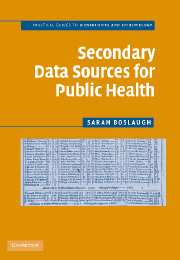Book contents
- Frontmatter
- Contents
- Preface
- Acknowledgments
- 1 An Introduction to Secondary Data Analysis
- 2 Health Services Utilization Data
- 3 Health Behaviors and Risk Factors Data
- 4 Data on Multiple Health Topics
- 5 Fertility and Mortality Data
- 6 Medicare and Medicaid Data
- 7 Other Sources of Data
- Appendix I Acronyms
- Appendix II Summary of Data Sets and Years Available
- Appendix III Data Import and Transfer
- Bibliography
- Index
5 - Fertility and Mortality Data
Published online by Cambridge University Press: 03 December 2009
- Frontmatter
- Contents
- Preface
- Acknowledgments
- 1 An Introduction to Secondary Data Analysis
- 2 Health Services Utilization Data
- 3 Health Behaviors and Risk Factors Data
- 4 Data on Multiple Health Topics
- 5 Fertility and Mortality Data
- 6 Medicare and Medicaid Data
- 7 Other Sources of Data
- Appendix I Acronyms
- Appendix II Summary of Data Sets and Years Available
- Appendix III Data Import and Transfer
- Bibliography
- Index
Summary
This chapter discusses seven sources of fertility and mortality data for the United States. Through the National Vital Statistics System (NVSS), the NCHS collects and makes available in one location information about vital events (births, deaths, marriages, divorces, and fetal deaths) in the United States and U.S. territories. The Compressed Mortality File (CMF) contains information about U.S. deaths in the years 1968 to 2002, aggregated to the county level and weighted to represent the national population for a given year. The National Death Index (NDI) is a centralized index of death record information within which the NCHS will perform searches to inform researchers of the vital status and cause of death of their subjects. The National Mortality Followback Survey (NMFS) collects information through interviews and administrative sources on a sample of individuals who died in the United States in a given year. It is conducted periodically, and each administration has focused on different topics, which have included risk factors, disability, health care utilization, and the reliability of death certificate information. The National Maternal and Infant Health Survey (NMIHS) was the first national survey to collect data on births, fetal deaths, and infant deaths simultaneously. It was conducted in 1988, with a Longitudinal Followup (LF) in 1991. The Pregnancy Risk Assessment Monitoring System (PRAMS) collects data that supplements that available on birth certificates, including maternal experiences and attitudes during pregnancy, while giving birth, and shortly after giving birth. It is an ongoing study that was initiated in 1987.
- Type
- Chapter
- Information
- Secondary Data Sources for Public HealthA Practical Guide, pp. 65 - 82Publisher: Cambridge University PressPrint publication year: 2007



